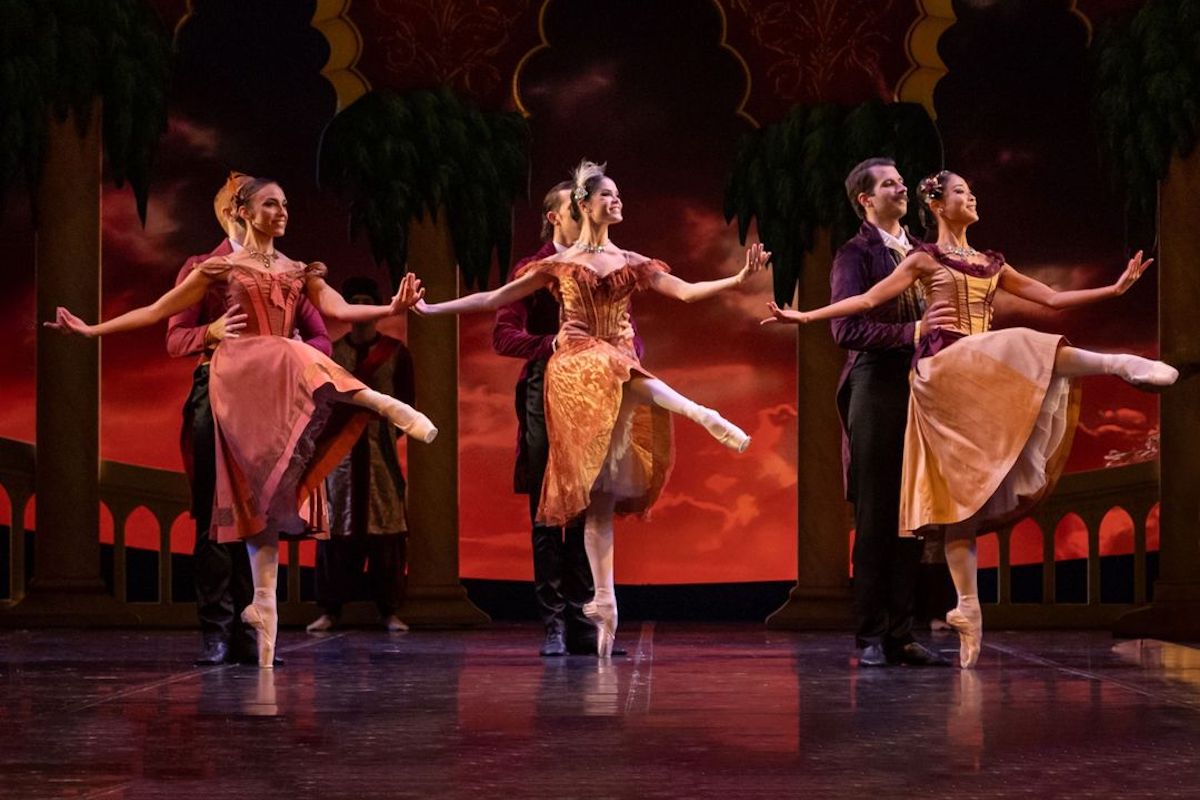La Bayadere, aka The Temple Dancer, one of Marius Petipa’s resplendent ballets, opened in St Petersburg Theatre in 1887 and it hit the spot for an audience obsessed with anything oriental. Its story of doomed love helped a bit, too, as did its visual cornucopia.
Choreographers of that period had a thing about deceased, unrequited love-maidens descending from the spiritual world bent on revenge – a perfect opportunity for spectacular costumes and sensational entrances and exits.
In Petitpa’s Bayadère this event occurs in the second act with the Entrance of the Shades, where maidens in white tutus descend a winding path in silhouetted splendour, and (hopefully) in perfect and beautifully devised synchronicity. It’s rather like watching a cascading waterfall obeying, in slow motion, the pull of gravity. It must have been amazing in Petipa’s time – he had a corps of 64 ballerinas.
It is still, in the parlance of today, the money shot, the scene that ensures La Bayadère’s continued programming, because, not withstanding its demanding choreography and the thrill of watching soloists master the virtuosity their roles call for, it is not the sum of its parts.
Although lauded Australia choreographer Greg Horsman has reimagined Petipa’s composition, Nigel Gaynor re-arranged Ludwig Minkus’s score (conductor Jessica Gethin coaxed, as usual, moments of sublimity from the West Australian Symphony Orchestra), parts of the first and third acts are mostly step-siblings to the second.

Dancers of West Australian Ballet’s La Bayadère. Photo supplied
The narrative begins with Indian and British soldiers brandishing swords at each other. We then see mimed elements that set up the plot in which Indian prince Solor (Gakuro Matsui) is told, as an act of appeasement, he must marry the spoilt English wanna-be princess Edith (Mayume Noguromi). But he’s in love with the Temple Dancer (Chihiro Nomura).
It takes a tedious amount of miming to get to this stage. The huge screen behind which we see some of the opening action is enough to tell the setting, decorated as it is with a very young Queen Victoria between warring Indian and British soldiers.
The last scene, depicts a ubiquitous Jane Austinesque British ballroom with handsome men in stiff cavalry gear and pretty maids all in a row, but ends with a film noir scene that could have come from the 1950s.
It’s no wonder that many, including Rudolph Nureyev (for the Royal Ballet) have lifted the second act as a stand-alone Pepita pièce de résistance. However, if you want to see a ballet which has all the known virtuoso cameos that create euphoria for most balletomanes, The West Australian Ballet’s Bayadère, if only for the absolute delight of the Kingdom of the Shades sequence, is a must.
First of all it’s a spectacular visual masterpiece, with sumptuous sets and costumes (Gary Harris) capturing the explosive colours, passions, and exoticism of of the scimitar-wielding Indians versus the stiff uniformity of the British cavalry. The finale, enhanced by Jon Buswell’s lighting, sets the stage ablaze with a stunning backdrop of red and gold.
Nomura and Noguromi were simply sensational in their skill – equal to the diamond-sharp precision demanded of them. Combined with dramatic prowess, Nomura with her lithe sinuousness exemplified Niklya’s haunting beauty and unhappiness. Noguromi, again with superb control, hit the villainous core of Edith’s persona right on the head.
Matsui as the love-tormented hero cruised through the demands of the choreography. Exquisite in technique, he was up to the dramatic core of his role, but seemed just slightly less energetic than is his want on this opening night. That said, his duets with Noguromi and particularly with Nomura were at times breath-taking in all their pathos and yearning.
Visions of delight were David McAllister as the rainbow coloured lndian King, the tall handsome Indian guard Juan Carlos Osma in a red bejewelled robe, and the bedecked golden body of Julio Blanes, The Golden Idol, who had a lot more dance to do and, as usual, was technically outstanding.
Less resplendent the very British Craig Lord-Sole could do nought but constrain the wish to throttle the evil and recalcitrant Edith and beat Matsui into submission – a role perhaps close to his heart as he is the WAB’s Rehearsal director.
Accolades on the night too, to the very watchable and exciting Adam Alzaim, Oliver Edwardson, Jeurgen Rahimi and Jack Whiter.
Having heard how anxious dancers get when performing the demanding Entrance of the Shades, it must be said that on this opening night the 16 Shades looked amazing and nailed it, as did the Shade soloists Candice Adea, Polly Hilton and Alexa Tuzil.
La Bayadère might not come this way again for many a year so it might be a good idea to catch it now if you can.
La Bayadère is performed at His Majesty’s Theatre, Perth until 20 April.











Comments
Log in to join the conversation.